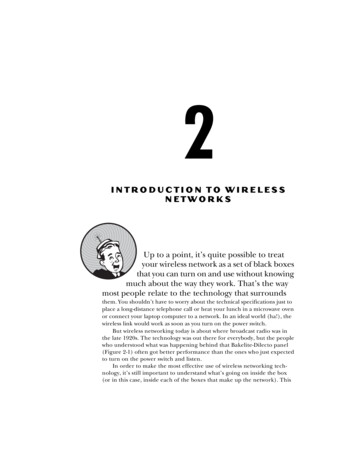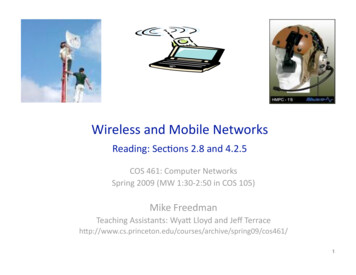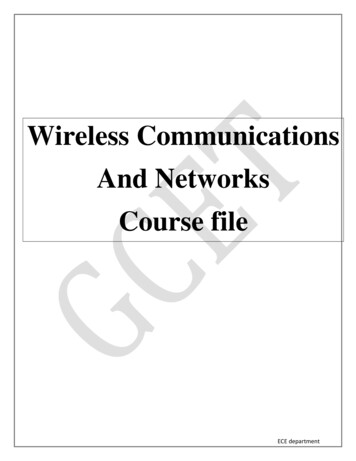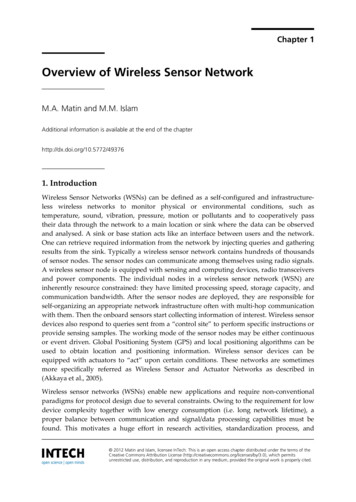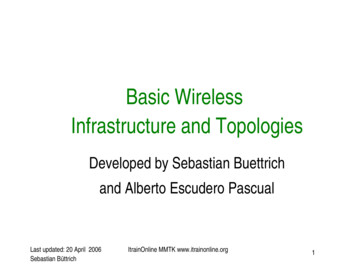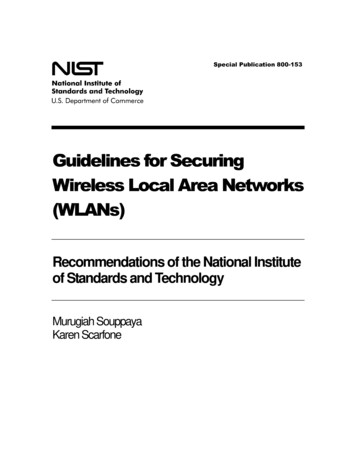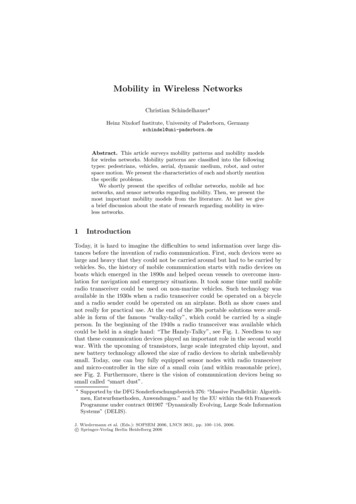
Transcription
Mobility in Wireless NetworksChristian Schindelhauer Heinz Nixdorf Institute, University of Paderborn, Germanyschindel@uni-paderborn.deAbstract. This article surveys mobility patterns and mobility modelsfor wirelss networks. Mobility patterns are classified into the followingtypes: pedestrians, vehicles, aerial, dynamic medium, robot, and outerspace motion. We present the characteristics of each and shortly mentionthe specific problems.We shortly present the specifics of cellular networks, mobile ad hocnetworks, and sensor networks regarding mobility. Then, we present themost important mobility models from the literature. At last we givea brief discussion about the state of research regarding mobility in wireless networks.1IntroductionToday, it is hard to imagine the difficulties to send information over large distances before the invention of radio communication. First, such devices were solarge and heavy that they could not be carried around but had to be carried byvehicles. So, the history of mobile communication starts with radio devices onboats which emerged in the 1890s and helped ocean vessels to overcome insulation for navigation and emergency situations. It took some time until mobileradio transceiver could be used on non-marine vehicles. Such technology wasavailable in the 1930s when a radio transceiver could be operated on a bicycleand a radio sender could be operated on an airplane. Both as show cases andnot really for practical use. At the end of the 30s portable solutions were available in form of the famous “walky-talky”, which could be carried by a singleperson. In the beginning of the 1940s a radio transceiver was available whichcould be held in a single hand: “The Handy-Talky”, see Fig. 1. Needless to saythat these communication devices played an important role in the second worldwar. With the upcoming of transistors, large scale integrated chip layout, andnew battery technology allowed the size of radio devices to shrink unbelievablysmall. Today, one can buy fully equipped sensor nodes with radio transceiverand micro-controller in the size of a small coin (and within reasonable price),see Fig. 2. Furthermore, there is the vision of communication devices being sosmall called “smart dust”. Supported by the DFG Sonderforschungsbereich 376: “Massive Parallelität: Algorithmen, Entwurfsmethoden, Anwendungen.” and by the EU within the 6th FrameworkProgramme under contract 001907 “Dynamically Evolving, Large Scale InformationSystems” (DELIS).J. Wiedermann et al. (Eds.): SOFSEM 2006, LNCS 3831, pp. 100–116, 2006.c Springer-Verlag Berlin Heidelberg 2006
Mobility in Wireless NetworksFig. 1. The Handy-Talky101Fig. 2. The Mica2Dot from CrossbowAlso the underlying radio communication technology has changed much fromthe analogous broadcast signal (still surprisingly widely distributed) to digitalmulti-hop networks with time, frequency and code division multiplexing for theparallel use of the medium. Such packet oriented radio devices have been developed in the 1970s and filled the interior of a van, i.e. Vint Cerf’s Stanford Research Institute (SRI) van. Then, the packet radio underwent a miniaturizationprocess and packet radio has become the dominating radio technology, so far.For two-way radio communication central radio stations are used which serveas relay station for transmitting the radio signals. Many of these central relaystations partition the radio landscape into cells. In such cellular networks themobility of users (more or less) reduces to problems of handover from one radiostation to a neighbored station. Networks without such centralized infrastructureare called mobile ad hoc networks. There, the impact of mobility is much higher,since everything is moving. One can easily imagine the possible negative impactof mobility on wireless networking. Recent results point out that mobility hasalso a positive impact.This article surveys mobility and radio networks from a wide perspective.We refrain from going into the very details of mobility aspects and head forgiving a broader picture. The goal of this survey is to endorse new approaches tomobility in wireless networks based on the current situation. For this, we discusson mobility patterns, mobility models, algorithmic aspects and on mobile ad hocnetworks. Very often the mobility models and mobility patterns are mixed up.However, one must carefully distinguish between them. Real mobility patterncan be obtained by tracking moving objects of reality, while mobility models tryto generalize such patterns by forming a mathematical model.We begin with a very short introduction of cellular networks, ad hoc networks,and wireless sensor networks. Then, we continue with an overview how andwhere mobility occurs and how it might affect wireless networks. After that we
102C. Schindelhauerelaborate mobility models from literature. In the last section we present positiveaspects of mobility on the wireless networks, research perspectives, and openresearch problems.This is not the first survey on mobility of wireless networks. There is anexcellent survey paper of Camp, Boleng and Davies [12] which presents anddiscusses mobility models for ad hoc networks. It is based on the more detailedPhD thesis of Vannessa A. Davies [17]. A survey of random direction basedmodels can be found in [41].2Wireless Networks in a NutshellThe radio frequency spectrum is divided into several bands, starting as low as30 kHz for maritime communication and ranging up to 300 GHz. Low frequencyradio waves easily pass through human bodies, walls, water, etc. Higher frequencies are absorbed and reflected by obstacles. There are numerous other facts tobe told from physics. For some frequency bands the ionosphere reflects signals.The background noise level differs in various bands. Signal strength is influencedby obstruction, diffusion, reflection, multi-path fading, and the Doppler effect.A man-made problem is the interference of radio signals of multiple senders.Furthermore, in theory the signal strength is fading with a power of two withrespect to the distance, which is only true in empty space. In other environmentsthe exponent is larger and can have values from 3-5. This implies that if one triesto send over a distance of d transmission power has to chosen d2 in emptyspace. Many transmission models assume that the covered area by a radio signalcan be modeled by a disc. However, practical measurements show that this isnot at all the case.2.1Cellular NetworksCellular networks are defined by static base stations which divide the fields intocells. All radio communication is between these base stations and the clients.Usually, each static base station forwards and receives packets to other base stations by another (hard-wired) network. Regarding movement of clients one is onlyinterested in whether the node enters or leaves a cell. It is not interesting wherethe node is exactly located within a cell. In some cellular networks (like UMTS)the size of the cell changes with the number of nodes. Usually network cells overlap and so, there are areas where a client can choose among several base stations.The main mobility problems and applications for cellular networks are Cellular Handoff: Provide a robust protocol that allows to move between cells withoutinterrupting and disturbing communication; Location Service: Use the cell information and the power strength to locate a client within the network.2.2Mobile Ad Hoc NetworksA Mobile Ad Hoc Wireless Network (MANET) is a self-configuring network ofmobile nodes. Nodes serve as routers and may move arbitrarily. There is no
Mobility in Wireless Networks103static infrastructure and the communication network must be able to adapt tochanges because of movement and other dynamics. Most of the MANET protocols do not assume that position data is available. However, if such positiondata is available then efficient location based communication protocols are applicable (for a survey on such routing algorithms see [39]). The main problemin MANET is to find a multi-hop route between the source and the target ofinformation. It is clear that if all the intermediate router nodes are movingthat this type of network is very much affected by mobility. Especially if onetakes into account that the transmitting range is rather restricted to a limited supply of energy (e.g. batteries). See [44] as an introduction to ad hocnetworks.The main mobility problems for a MANET are routing a message, multicasting a message, and upholding the network routing tables for these issues.2.3Sensor NetworksA sensor network is a wireless network connecting many, specially distributedsensor devices. These devices are equipped with sensors, such as for temperature,vibration, pressure, sound, or motion. Like in a mobile ad hoc network this information has to be communicated without a special infrastructure over a multi-hoppath. Similar as for cellular networks there are specially equipped base stations(sometimes connected over an ad hoc network) to collect this information andcontrol the network.The main difference between a sensor network and a mobile ad hoc networkis that a sensor network is data-driven. It is important to receive the temperature reading of an area not from a specific device. So, some of the sensors maybe switched off for most of the time. Furthermore, these cheap and massivelydeployed sensors are equipped with the bare minimum of computing resources.Sometimes they have to work for some 10 years being solely powered by smallcoin cell batteries.The main application of a sensor network is to read out the sensor reading of a particular area. At the moment mobile sensor networks are the exception (which we will discuss here). For surveys on sensor networks, see [14], [30],[46], [57].3Mobility Patterns: How People and Things MoveWe now give a overview over realistic mobility patterns and classify them asfollows: pedestrians, vehicles, aerial, dynamic medium, robot, and outer spacemotion. We present their characteristics and mention the specific radio problems.3.1PedestriansThe oldest and most common way of mobility is to walk. Pedestrian mobilityhas the slowest velocity compared to other modern mobility patterns. Althoughlow in speed, even in cellular networks walking patterns cause sincere trouble
104C. Schindelhauersince typically people walk through places where obstacles obstruct the signal.It is often a matter of meters whether or not the access point is to be reachedby a client (fast signal fading). In such a case clients need to be handed overrapidly to the next available access point.So, pedestrian mobility describes the walking patterns of people or animals.Its main characteristics are the full use of the two-dimensional plane with occasional obstacles and its chaotic nature. Group behavior may occur, but has notnecessarily to be. Such pedestrian mobility is always limited in speed becausethe legs act like inverted pendula.Typical examples of pedestrian mobility in wireless networks are people in thestreet or mall using cellular phones or PDAs (personal digital assistants), andanimals in herds with sensor nodes being observed by biologists, e.g zebras [56].Upcoming examples of wireless mobility patterns are mobile devices attached toany moving object (parasitic mobility) [31], or even radio devices for pets. A sideeffect is that pedestrian clients have limited energy-resources. So they need tocarry their batteries around to communicate, by that imposing further restraintsto the communication network.3.2Marine and Submarine MobilityLike pedestrians boats and vessels are limited by an intrinsic maximum speed,resulting from the friction in the water and the available motor power. Unlikein vehicular (earth bound) mobility the motion is truly two-dimensional, and inthe case of submarine mobility even three-dimensional, whereas for most casesno group mobility is involved (except regattas, fleet operation and fish swarms).The communication upon the water service is very good and only the globe’scurvature may become a problem.Water absorbs radio signals with high frequencies. Submarine boats circumvent this problem by using very low frequencies ranging form 15 kHz to 33 kHzwith an antenna length of 10 to 20 meters. A solution to this problem is acousticcommunication, since sound travels very well underwater [2]. Also under water speed is the decisive limitation to mobility. Unlike in aerial mobility ascentand descent is easily possible (if the devices are equipped to withstand to theenormous changes of water pressure), so truly three-dimensional movement isrealistic.3.3Earth Bound VehiclesSuch as pedestrian mobility is connected to the pendulum, the vehicular mobilityis connected to the wheel. By this term we describe the mobility patterns of cars,railways, bicycles, motor bikes, etc. The wheel based movement reduces frictionand allows high speed. So, the danger of collision increases dramatically, and thisis the reason why (nearly) all vehicles are bound to one-dimensional movementon streets, paths, or tracks. This reduces the problem of preventing collisions tocertain places like crossings.
Mobility in Wireless Networks105For railway traffic there is fixed predictable train schedule and only delayscause aberrations. However, even in the seemingly well-planned world of therailway companies, freight wagons do disappear. This happens very often in thelarge wide-spread network of railway system spanning over different countriesand railway network providers. Therefore, some companies start to use GPSbased wireless tracking devices to locate the wagons.Another feature of railway traffic is an extreme group mobility pattern. Whenthe passengers are inside a train, then their relative speed reduces to nearly zero,while the whole train can move up to some 300 km/h. The high relative speedbetween trains makes direct communication very challenging, especially sincethey move through a landscape with obstacles, or even tunnels. At these speedsthe Doppler-effect starts to kick in. Further the noise of reflections of the scenerydecreases the quality of the connection.A very interesting study of this effect in practice can be seen in [38]. It showsthe difficulty that already arises if cars traveling on the same road in the samedirection communicate with each other over W-LAN, both in simulation and inpractice. Even a street sign impacts the quality of communication by its reflectionof radio signals.3.4Aerial MobilityIn this context monitoring flying patterns of migratory birds is a challenging taskfor biologists. In former times, marking caught exemplars was the only reliablesource of information. Nowadays, some birds are equipped with radio trackingdevices and can be publicly monitored over the Internet, likewise the monitoringof the black storks by the WWF1 .Flying objects reach high speeds and travel over long distances. Actually birdsand airplanes behave quite similar, here. As a communication medium open airis nearly optimal. Still, the signal fades quadratically with the distance, suchthat multihop communications may reduce the energy consumption of the radiotransceiver.The aerial mobility pattern can be best described as a two and a half dimensional individual movement with limited (yet high) speed. The motion isnot completely three-dimensional since each ascent is very costly to the flyingobject. So, flying objects usually preserve their flight heights. One exceptionmay be air fights between a raptor and his prey, or flight combats between warplanes. Another exception is the group mobility of bird swarms which perfectlycoordinate their flight behavior.The main applications of radio communication in aerial mobility are anticollision systems, message passing, position tracking, and of course flight control.3.5Medium Based MobilityOne method to explore the interior of hurricanes are dropwindsondes [18]. Theseare sensor devices dropped from an airplane equipped with a parachute, sensors,1See http://www.flyingover.net/
106C. SchindelhauerGPS-system, and a radio unit. Besides the constant drop speed the main movement comes from the interior winds of the hurricanes. Other wireless devices withmedium based mobility are weather balloons and drifting buoys in the oceans. Themain application of all these devices is to measure the currents of the medium.Dropwindsondes communicate directly to the aircraft releasing them. Also forother such sensor nodes cellular networks is the prevalent technique to collect thetracking information. A different approach has been used for measuring the currents at the British coast. In [47] a mobile ad hoc network has been used to collect the information of the sensor network over a multihop path (with hardwareequipped as few as 384 Bytes of RAM). Using flying sensor devices for the exploration of mars was recently suggested by [3].To understand the mobility of the sensor devices in the medium one has tostudy the medium itself. This can be done by numerical solution of the underlyingNavier-Stokes-equations. Medium based mobility can be one-, two- or threedimensional depending on the medium and the circumstances (piped gas, surfaceof fluids, open air). Group behavior can occur and is usually unwanted sincegrouping sensors deliver less information than individual moving sensors.3.6Mobility in Outer SpaceFor radio communication outer space is the perfect environment. Energy forcommunication is usually no tight resource since space vehicles are equippedwith solar paddles. Mobility is, however, restricted since common space shipsuse rockets for acceleration and fuel supply is limited. Hence, space vehiclesdrift through space most of the time to save on this resource. At the momentnumerous satellites surround the earth forming a mobility pattern of a giantchaotic carrousel, see Fig. 3. But space explorations may produces even morecomplicated mobility patterns.Space ships closely fly by planets to increase speed, e.g. Voyager 2 used Saturn’s strong gravity to change its course and gather speed (to continue its missionto Uranus and Neptune). Herds of space vehicles may be used for a coordinatedview into deep space. These herds will be placed in non-circular orbits betweenearth and sun. Note that there exist five further stable positions, called Lagrangeor libration points (see Fig. 4), between every pair of massive bodies such thesun and its planets, the planets and their moons, and so on. And around theseLagrange points non-circular orbits exist, see Fig 5. These herds of space vehicles have to change formation from time to time forming complicated mobilitypatterns. Ad hoc networks will coordinate this movement, prevent collisions andrecalibrate the relative positions [29].3.7Robot MotionAny of the above mobility scenarios can occur in robot motion. The main difference is the mobility pattern given by the designer of the robots. For someapplication this pattern is easy to predict, likewise other robots seem to movecompletely erratic and unpredictable. Clearly, the robot motion is driven by the
Mobility in Wireless Networks107Fig. 4. The five Langrange points [28]Fig. 3. Space vehicles and debris in loworbit (from NASA Orbital Debris ProgramOffice)Fig. 5. Family of Halo orbits in the vicinityof the Lagrange point [28]robot’s task and usually little attention is given to the impact of the robot’sbehavior on the communication network.Currently, in Paderborn the project “Smart Team”2 has been launched tomake a difference. The goal of this project is to coordinate the robots’ task withthe necessities of a radio communication network.3.8Characterization of Mobility PatternsWe have seen that in our modern world mobility is manifold and ubiquitous.Radio communication networks are strongly affected by the different types ofmobility and the understanding of each observed mobility pattern can help toimprove the network behavior. Throughout this section the following propertiesplayed a role.– Group behavior : Is there a set of nodes staying together for a considerablylong time? Clearly, exploiting group behavior improves the performance ofradio communication by clustering.– Limitations: What are the speed and/or acceleration bounds in the mobilitypattern?– Dimensions: Do the nodes move in three-dimensions or only planar or linear?2Funded by the DFG SPP 1183 Organic computing.
108C. Schindelhauer– Predictability: How well can the behavior of the nodes be predicted, e.g.by a simulation model? Is the behavior completely erratic? Or can it bedescribed by a random process or even by deterministic selfish behavior?Also hybrid models might appear. In this context we would like to mentionthe parasitic mobility pattern [31]. They present a sensor network where thenodes harvest the mobility from people, animals, vehicles, fluids, cellular organisms, and nature. Furthermore, the nodes can change hosts. Depending on thetype of host, parasitic mobility can reproduce nearly all of the above mobilitypatterns. Such parasitic mobility pattern does not constitute a mobility patternof its own.3.9Measuring Mobility Patterns by LocalizationTo measure a mobility pattern one needs to track a large number of nodes fora long period of time. In fact this is the perfect application area for wirelesssensor networks specialized in localization. Localization can be solved by measuring ranging information from signal strength [5], time of arrival [53], or thetime difference of arrival [50], or angle of arrival [42]. Other localization schemesmake use of the quantities of base stations seeding sensors. Some hopcount basedtechniques avoid this large number of seeding base stations, [43], [45] by relyingon a uniform node distribution. In [26] a different approach is presented. Theyexploit the mobility of the sensor networks to improve the accuracy and reliability of the sensor node localization even if the sensors are seeded by mobile basestations. This is only one of many examples where mobility helps to improve thenetwork behavior.4Models of MobilityWe classify the mobility models as cellular mobility models, random trip models,group mobility models, particle based models, non-recurrent models, and worstcase mobility models.4.1Cellular Mobility ModelSince for cellular networks the main aspect of mobility is the handoff betweencells, one is not particularly interested in every detail of the movement of a mobilenode. For a survey for cellular models see [32].1. The Random Walk ModelIn this model, a node stays in a cell or moves to a neighbored cell according tosome given transition probabilities. These probabilities are often adjusted topractical observations of client behavior in cells. The Random Walk MobilityModel is one of the most widely used mobility models because it describesindividual movements relative to cells [7, 49, 58]. Since this model is memoryless, there is no such concept as a path or consecutive movement. Therefore,nodes stay in a vicinity of the starting cell for a rather long time.
Mobility in Wireless Networks1092. Trace based ModelsCellular phone companies have large records of mobility patterns of theirusers. These traces are a valuable source for the evaluation and improvementof handoff protocols. The only drawback is that usually such data is notpublicly available and therefore cannot serve as benchmarks for the scientificcommunity.3. Fluid Flow Mobility ModelIn this model the individual nodes are modeled on a macroscopic level [32],[54], [36], [52]. The behavior of the generated traffic is similar to a fluidflowing through a pipe. As a result, the Fluid-Flow Mobility Model representstraffic on highways very well (for cellular networks). In [33] this model is usedto represent the behavioral characteristics of traffic on a highway. [34] showsthat the Fluid-Flow Mobility Model is insufficient for individual movementsincluding stopping and starting.4.2Random Trip MobilityThese mobility models are the prevalent mobility model for MANETs. There arenumerous variants of this model. In [12] these models are presented as follows.1. Random Walk Mobility ModelEach node moves from its current location to a new location by randomlychoosing an arbitrary direction and speed from a given range. Such a move isperformed either for a constant time for a constant distance traveled. Thennew speed and direction are chosen. At the boundaries nodes bounce off likebilliard balls on a pool table.In [34] the Random Walk Mobility Model is described as a memoryless mobility pattern because it retains no knowledge concerning its pastlocations and speed values. This characteristic inhibits the practicality ofthe Random Walk Mobility Model because mobile nodes typically have apre-defined destination and speed in mind, which in turn affects future destinations and speeds.One observation is that the stationary probability distribution can bedescribed depending on the probabilites. But, the convergence against thisstable distribution can be slow, if the points are not randomly chosen [55].So, there is some danger that the simulation result highly depends on thestart position, if the simulation time is not long enough.In the Smooth Random Mobility Model [9] an extension of the simplerrandom walk model is given. Here, two independent stochastic processeschoose direction and speed changes. The new speeds (or directions) are chosen from a weighted distribution of preferred speeds. Upon a trigger, thespeed (resp. direction) changes as determined by a Poisson process.2. Random Waypoint Mobility ModelThe model is equivalent to the Random Walk model except that before anychange of speed and direction a predetermined pause time is performed [11].This model is widely used for evaluating ad hoc network routing protocols.
110C. Schindelhauer3. Random Direction Mobility ModelHere, the node must travel to the edge of the simulation area (or some othercondition is met) at a constant speed and direction. Then, the nodes pauseand a new direction and velocity is chosen randomly [48]. Then, the processrepeats.4. A Boundless Simulation Area Mobility Model: The model exchanges theplanar rectangular simulation field by a boundless torus.5. Gauss-Markov Mobility Model: A model that uses one tuning parameter tovary the degree of randomness in the mobility pattern.The Random Gauss-Markov Mobility Model is introduced as an improvement over the Smooth Random mobility model [34]. A node’s next location isgenerated by its past location and velocity. Depending upon parameters set,this allows modeling along a spectrum from Random Walk to Fluid-Flow.6. A Probabilistic Version of the Random Walk Mobility Model [15]In this model the last step made by the random walk influences the next one.Under the condition that a node has moved to the right the probability thatit continues to move in this direction is then higher than to stop movement.This leads to a walk that leaves the starting point much faster than theoriginal random walk model.7. City Section Mobility Model [17]Here the random waypoint movement is combined with a street map ofa virtual city. The paths of the mobile nodes are limited to these streets inthe field. In a related model, the streets are replaced by Voronoi graphs [27].Furthermore, obstacle are used which obstruct also radio signals.For some models there is a slow convergence towards the stationary distribution [40]. This influences simulation results, since in previous work simulationusually starts with the uniform distribution which is not necessarily the stationary distribution of the mobility model. Some random waypoint models do notprovide a stationary distribution at all. These problems are mentioned in [55]for many random waypoint mobility models.In [10] the Random Trip model has ben defined. This model describes a wideclass of mobility models, contain most of the mobility models in this section.Therefore we use this name for this class of mobility models. Examples includerandom waypoint on general connected domain, restricted random waypoint,random walk models with either wrap-around or reflection, and the city streetmodel. In [10] it is shown how a simulation algorithm can start from uniquesteady-state distribution. So, no time must be spent for waiting until the randomprocess stabilizes in the simulator.4.3Group-Mobility ModelsThe group-mobility models are usually an extension of the above models, whereeither a function describes the group behavior or the nodes are somehow associated with a group leader or a target. For a more extensive description of thesemodels we refer to [12] and [25].
Mobility in Wireless Networks1111. Exponential Correlated Random Mobility Model: Here a motion functioncreates a group behavior.2. Column Mobility Model: The set of mobile nodes form a line and moveforward in a particular direction.3. Nomadic Community Mobility Model: A group mobility model where a setof MNs move together from one location to another.4. Pursue Mobility Model: For each group the group members follow a targetnode moving over the simulation area.5. Reference Point Group Mobility Model: The group movement is based uponthe path traveled by a logical center. Again the logical center moves accordingto an individual mobility model.4.4Particle Based MobilityThere has been a lot of research in predicting pedestrian behavior. One ofthe main motivations is to understand erratic mass panic caused by manypedestrians causing the death and injuries of hundreds of people in a singleevent [24]. The best model to describe the individual behavior of each person in such occasions is a particle based model [23]. Each person is characterized by a sum of forces, describing his desire to move in a direction, keepinga distance to others and the result of contact and frictions with other persons. The simplicity and the accuracy of this model is surprising. It allowseven to simulate typical behavior in crowded streets where strangers form queuepatterns.4.5Combined Mobility ModelsMany the above mobilit
aspects of mobility on the wireless networks, research perspectives, and open research problems. This is not the first survey on mobility of wireless networks. There is an excellent survey paper of Camp, Boleng and Davies [12] which presents and discusses mobility mod

